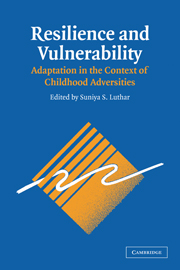Book contents
- Frontmatter
- Contents
- List of Contributors
- Foreword by Dante Cicchetti
- Preface
- 1 A Resilience Framework for Research, Policy, and Practice
- PART I FAMILIAL ADVERSITIES: PARENTAL PSYCHOPATHOLOGY AND FAMILY PROCESSES
- PART II EXOSYSTEMIC AND SOCIODEMOGRAPHIC RISKS
- PART III COMMENTARIES
- 19 Toward Building a Better Brain: Neurobehavioral Outcomes, Mechanisms, and Processes of Environmental Enrichment
- 20 Genetic Influences on Risk and Protection: Implications for Understanding Resilience
- 21 Research on Resilience: An Integrative Review
- Index
- References
19 - Toward Building a Better Brain: Neurobehavioral Outcomes, Mechanisms, and Processes of Environmental Enrichment
Published online by Cambridge University Press: 05 June 2012
- Frontmatter
- Contents
- List of Contributors
- Foreword by Dante Cicchetti
- Preface
- 1 A Resilience Framework for Research, Policy, and Practice
- PART I FAMILIAL ADVERSITIES: PARENTAL PSYCHOPATHOLOGY AND FAMILY PROCESSES
- PART II EXOSYSTEMIC AND SOCIODEMOGRAPHIC RISKS
- PART III COMMENTARIES
- 19 Toward Building a Better Brain: Neurobehavioral Outcomes, Mechanisms, and Processes of Environmental Enrichment
- 20 Genetic Influences on Risk and Protection: Implications for Understanding Resilience
- 21 Research on Resilience: An Integrative Review
- Index
- References
Summary
Research over the second half of the 20th century has painted a very consistent picture of the impact of differential environments on the brain and behavior of various nonhuman animal species. Beginning with the early pioneering work of Hebb in the 1940s (1947, 1949), scores of studies have demonstrated that rearing animals in enriched environments results in discernible differences in both brain morphology and observable behavior when compared to animals reared in standard laboratory conditions. Many different animal species have been utilized in many variations on this basic experimental design and, invariably, similar results emerge. Indeed, it has become nearly axiomatic that exposing experimental animals to enriched environments leads to positive outcomes in terms of brain development and their ability to learn.
During the early and mid-1960s, when many of the initial animal enrichment experiments were first underway, a social and political experiment, also based on the idea of environmental enrichment, was being formulated. The central idea was that enrichment of the environment of disadvantaged children would result in enhanced cognitive development and social competence beyond that which would be expected in these children given the disadvantage of poverty. The juxtaposition of these two endeavors, one occurring in the realm of biological science and the other motivated by governmental social policy, was probably not coincidental. More likely, both were to some degree the result of a prevailing optimism in the culture during the 1960s about the potential for improving the human condition via modification of the environment.
- Type
- Chapter
- Information
- Resilience and VulnerabilityAdaptation in the Context of Childhood Adversities, pp. 463 - 488Publisher: Cambridge University PressPrint publication year: 2003
References
- 23
- Cited by

